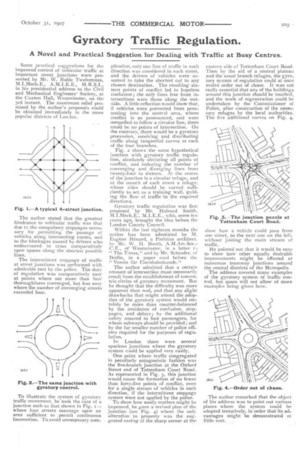Gyratory Traffic Regulation.
Page 15

If you've noticed an error in this article please click here to report it so we can fix it.
A Novel and Practical Suggestion for Dealing with Traffic at Busy Centres.
Some practical suggestions for the improved control of vehicular traffic at important street junctions were presented by Mr. W. Noble Twelvetrees, M. I . Mech. E. , A.M. I. E. E., M. R. S. I., in his presidential address to the Civil and Mechanical Engineers' Society, at the Caxton Hall, Westminster, on the 3rd instant. The maximum relief promised by the author's proposals could be obtained immediately in the more popular districts of 'London.
The author stated that the greatest hindrance to vehicular traffic was that due to the compulsory stoppages necessary for permitting the passage of vehicles along intersecting routes, and to the blockages caused by drivers who endeavoured to cross comparatively open spaces along the shortest possible lines.
The intermittent stoppage of traffic at street junctions was performed with admirable tact by the police. The duty of regulation was comparatively easy at points where not more than four thoroughfares converged, but less easy where the number of converging streets exceeded four.
To illustrate the system of gyratory traffic movement, he took the case of a junction such as that shown in Fig. '— where four streets converge upon an area sufficient to permit continuous locomotion. To avoid unnecessary corn
plication, only one line of traffic in each direction was considered in each street, and the drivers of vehicles were as sumed to take the shortest cut to any chosen destination. The resulting six teen points of conflict led to hopeless confusion ; the only lines free from intersections were those along the out side. A little reflection would show that, if vehicles were prevented from penetrating into the central area, where conflict is so pronounced, and were compelled to follow a circular line, there could be no points of intersection. On the contrary, there would be a gyratory procession, receiving and distributing traffic along tangential curves at each of the four branches.
Fig. 2 shows the same hypothetical junction with gyratory traffic regula
tion, absolutely obviating all points of conflict, and reducing the number of converging and diverging lines from twenty-four to sixteen. At the centre of the junction is a circular refuge,. and at the mouth of each street a refuge, whose sides should be curved suffi
ciently to act as a training wall, guiding the flow of traffic in the required directions.
Gyratory traffic regulation was first proposed by Mr. Holroycl Smith, M. I . Mech . E. , M.I . E. E. , who, some ten years ago, brought the idea before the London County Council.
Within the last eighteen months the notion has been advocated by M.
Eugene Henard, a Parisian architect, by Mr. W. H. Booth, A.M.Am.Soc.C.F., of Westminster, in a letter t.) " The Times," and by Mr. Schroder, of Berlin, in a paper read before the " Verein fur Fisenbahnkunde."
The author admitted that a certain amount of intersection must necessarily result from the establishment of concen tric circles of gyratory movement. But he thought that the difficulty was more apparent than real, and that any slight drawbacks that might attend the adoption of the gyratory system would cer tainly be more than counter-balanced by the avoidance of confusion, stoppages, and delays ; by the additional safety assured to foot passengers, for whom subways should be provided; and by the far smaller number of police officers required for the purposes of regulation.
In London there were several spacious junctions where the gyratory system could be applied very easily.
One point where traffic congregated' in peculiarly antagonistic fashion was the five-branch junction at the Oxford Street end of Tottenham Court Road. As represented in Fig. 3, this junction would cause the formation of no fewer than forty-five points of conflict, even for a single stream of vehicles in each direction, if the intermittent stoppage system were not applied by the police. To show how easily matters might be improved, he gave a revised plan of the junction (see Fig, 4) where the only alteration to property was the suggested easing of the sharp corner at the
eastern side of Tottenham Court Road. Then by the aid of a central plateau and the usual branch refuges, the gyra.. tory system of regulation could at once evolve order out of chaos. It was not really essential that any of the buildings around this junction should be touched, and the work of regeneration could be undertaken by the Commissioner of Police, after construction of the necessary refuges by the local authorities. The five additional curves on Fig. 4,
show how a vehicle could pass from one street, to the next one on the left, without joining the main stream of traffic.
He pointed out that it would be easy to show how other equally desirable improvements might be effected at numerous tramway junctions around the central districts of the Metropolis.
The address covered many examples of the gyratory system of traffic control, but space will not allow of more examples being given here.
The author remarked that the object of his address was to point out various places where the system could be adopted tentatively, in order that its advantages might be demonstrated at little cost.
























